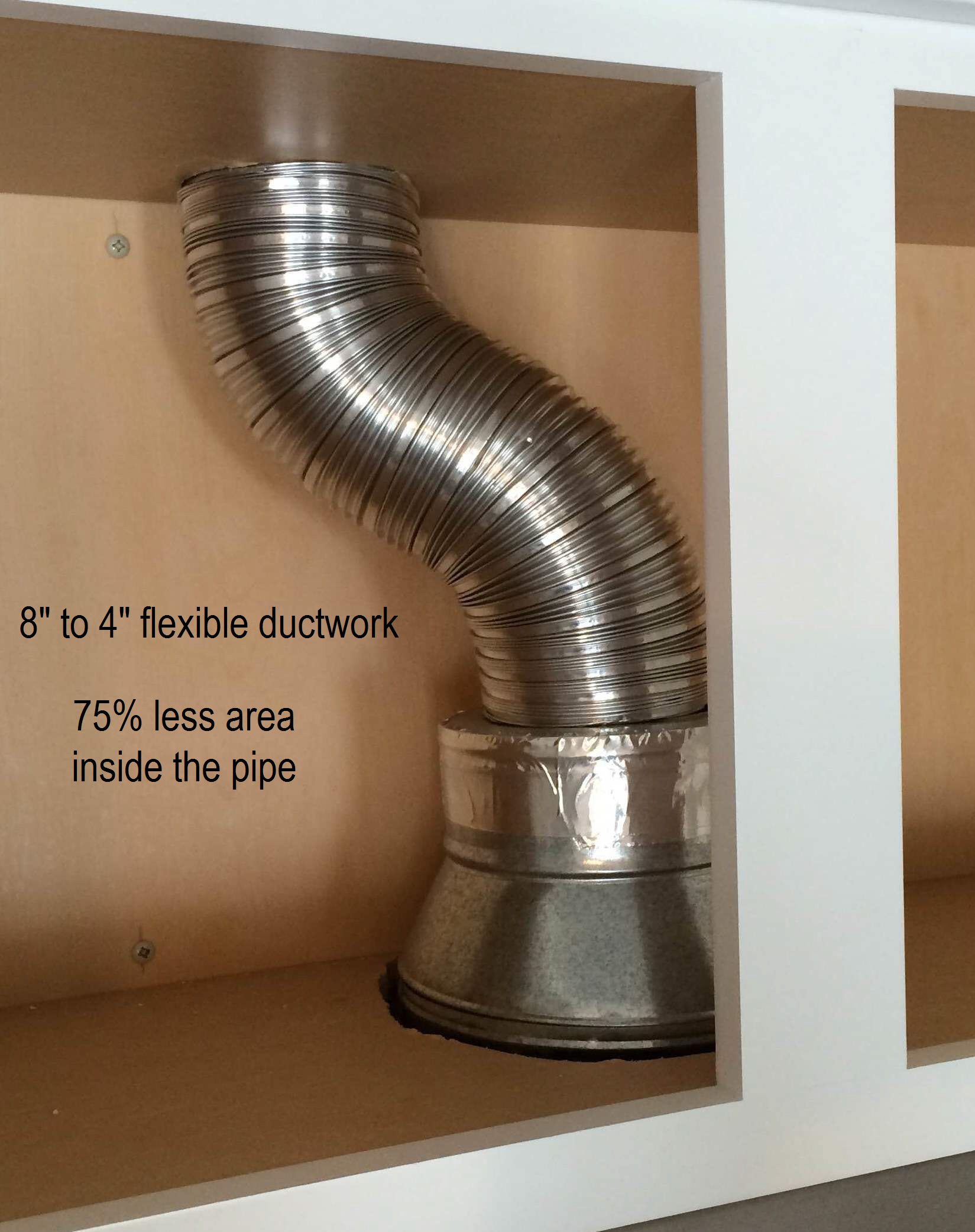There are a few factors to consider when selecting the size of duct for your range hood. The first is the size of your range hood. The second is the type of range hood you have.
The third is the size of your kitchen. And the fourth is the CFM (cubic feet per minute) rating of your range hood.
The size of your range hood is important because it will dictate how much air movement you need to move through the duct work.
The larger the range hood, the more powerful it will be and therefore, you will need a bigger duct to accommodate this airflow.
The type of range hood you have will also play a role in determining what size duct you need. If you have a vented range hood, then you will need a bigger duct than if you had an unvented one.
This is because ventedrange hoods remove air from inside your home, so there needs to be enough space for that removed air to go without affecting your home’s indoor air quality too much.
The size of your kitchen also comes into play when choosing aduct size for your range hood. If you have a small kitchen, then you won’t need as big of a duct as someone who has a large kitchen would.
This is because there isn’t as much space for air to travel in a small room, so less airflow is needed to achieve proper ventilation.
Last but not least, another factor that determines what size ductworkyou’ll need for your rangehood is its CFM rating. This stands for cubic feet per minute and it measures how muchairflow the unit can provide in one minute’s time span .
The higherthe CFM rating ,the more powerful the unit and therefore,you’ll likely need apowerful blower motor and accordingly sized venting systemto expel allof that captured cooking grease-laden vapors outside .
When it comes to range hoods, size does matter. The wrong size duct can cause all sorts of problems, from decreased air flow to back drafting. So how do you know what size duct is right for your range hood?
The first step is to determine the CFM (cubic feet per minute) rating of your range hood. This will tell you how much air it can move in a minute and is a good starting point for sizing your ductwork. Once you know the CFM, you can then determine the appropriate duct size by using this simple formula:
CFM x 100 = Minimum Duct Size (in inches)
For example, if your range hood has a CFM rating of 400, you would need a minimum duct size of 4 inches. Keep in mind that this is the minimum size required – larger sizes will provide even better airflow and should be used whenever possible.
Once you have the appropriate sized ductwork, it’s important to make sure it’s installed correctly. Improper installation can lead to all sorts of issues, so it’s best to leave this job to the professionals. With proper installation and sizing, your range hood will work like a charm – providing plenty of airflow and keeping your kitchen free of smoke and smells.
Ducting Do's and Dont's for Vent A Hoods – Kitchenfoundry.com
Can You Use 4 Inch Duct for Range Hood?
4 inch duct for range hood is perfectly fine and will not present any problems. The main thing to remember is that the total area of the duct should be at least 100 square inches. Also, make sure that the duct is installed properly so that it does not leak.
What Type of Duct is Best for Venting a Range Hood?
If you’re looking to vent a range hood, one of the best options is a duct made of galvanized steel. This type of duct is durable and resistant to rust, making it a great choice for use in high-moisture areas like kitchens. Galvanized steel ducts are also relatively easy to install, so you won’t need to hire a professional if you’re handy with tools.
Another good option for venting a range hood is PVC (polyvinyl chloride) pipe. This material is also resistant to moisture and corrosion, and it’s easy to work with, so it’s a good choice if you’re doing the installation yourself. PVC pipe is available in various diameters, so be sure to choose one that’s large enough to accommodate your range hood’s exhaust fan.
Finally, stainless steel ductwork is another option worth considering. Stainless steel has excellent corrosion resistance and can withstand high temperatures, making it ideal for use in kitchens. However, stainless steel can be difficult to work with and install, so it’s best left to the professionals if possible.
How Many Cfm is a 4 Inch Duct?
If you’re in the process of planning a ducted heating or cooling system for your home, you may be wondering how to determine the right size for your needs. One key factor is CFM, or cubic feet per minute. This measures the volume of air that can be moved by a fan through a ductwork system in one minute.
In general, the larger the space to be heated or cooled, the higher the CFM rating you’ll need.
For example, a small room like a bathroom might only require around 50 CFM, while a large living room could need 400 CFM or more. When it comes to 4 inch ducts specifically, they can typically move anywhere from 80 to 300 CFM of air.
The exact amount will depend on factors like the length and layout of your ductwork as well as the power of your blower motor.
To find out precisely how much airflow you need for your home, it’s best to consult with a professional HVAC contractor who can help design a system that meets your specific needs.
Should Your Vent Hood Be the Same Size As Your Range?
There’s no one-size-fits-all answer to this question, as the size of your vent hood should be based on a number of factors, including the size of your range and the type of cooking you do. However, as a general rule of thumb, your vent hood should be at least as wide as your range – preferably even wider. This will ensure that it can effectively capture all the smoke and fumes generated while cooking.


Credit: www.prolinerangehoods.com
Range Hood Vent Duct Kit
Most homes have a range hood vent over the stove. The purpose of this is to remove smoke, fumes and odors from cooking. Unfortunately, many homeowners do not realize that the range hood vent also needs to be vented to the outside of the home in order for it to work properly.
A range hood vent duct kit can make this process much easier.
A range hood vent duct kit typically includes everything you need to properly vent your range hood. This generally includes a length of flexible ducting, an exhaust cap and installation instructions.
Some kits also include clamps or tape to help secure the ducting in place.
If you are unsure whether or not your home’s range hood is properly vented, you can usually tell by looking at the back of the unit. If there is no ductwork connected to it, then it is likely that it is not vented correctly.
In this case, installing a range hood vent duct kit will be necessary.
Installing a range hood vent duct kit is generally a fairly easy process that most homeowners can do themselves. However, if you are unsure about how to properly install the kit, you may want to hire a professional contractor to do it for you.
Range Hood Duct Size Calculator
If you’re in the process of selecting a range hood for your kitchen, one of the most important factors to consider is the size of the ductwork. That’s why we’ve created this handy range hood duct size calculator. Just enter a few key pieces of information and we’ll do the rest!
First, tell us the width of your range hood: ____ inches.
Next, input the height of your ceiling: ____ feet.
Now, let us know how many bends or elbows are in your ductwork: ____ (0-3).
Finally, give us an estimate of the length of your ductwork: ____ feet.
Using all of this information, our calculator will determine what size range hood you need to properly ventilate your kitchen. Keep in mind that this is just a general guide – always consult with a professional before making any final decisions.
7 Inch Duct for Range Hood
If you’re in the market for a new range hood, you may be wondering what size ducting you need. A common size is 7 inches, but what does that mean for you and your home?
7 inch range hoods are designed to fit a standard kitchen exhaust fan opening.
They’re a good choice for most homes, as they provide adequate airflow while not being too large or bulky. Keep in mind that the actual ductwork going to your range hood may be larger than 7 inches, as this is just the size of the opening.
When choosing a range hood, it’s important to consider both the size of your cooktop and the amount of ventilation you need.
If you do a lot of cooking on high heat, you’ll need a range hood that can move more air to keep your kitchen comfortable. Likewise, if your cooktop is on the smaller side, you may be able to get away with a less powerful range hood.
No matter what size range hood you choose, make sure it’s properly vented to the outside of your home.
A quality range hood will have an efficient motor that doesn’t produce too much noise, and it will also have filters that trap grease and other particles from entering your ductwork. By keeping your ventilated and clean, you’ll ensure years of trouble-free use.
Conclusion
When it comes to range hoods, size does matter. The rule of thumb is that the range hood should be at least as wide as the stovetop or cooktop. But, if you have a powerful stove with high BTUs, you may need a wider range hood to vent all the smoke and odors.
Another factor to consider is the height of your ceilings. If you have high ceilings, you’ll need a taller range hood to effectively remove smoke and odors.

